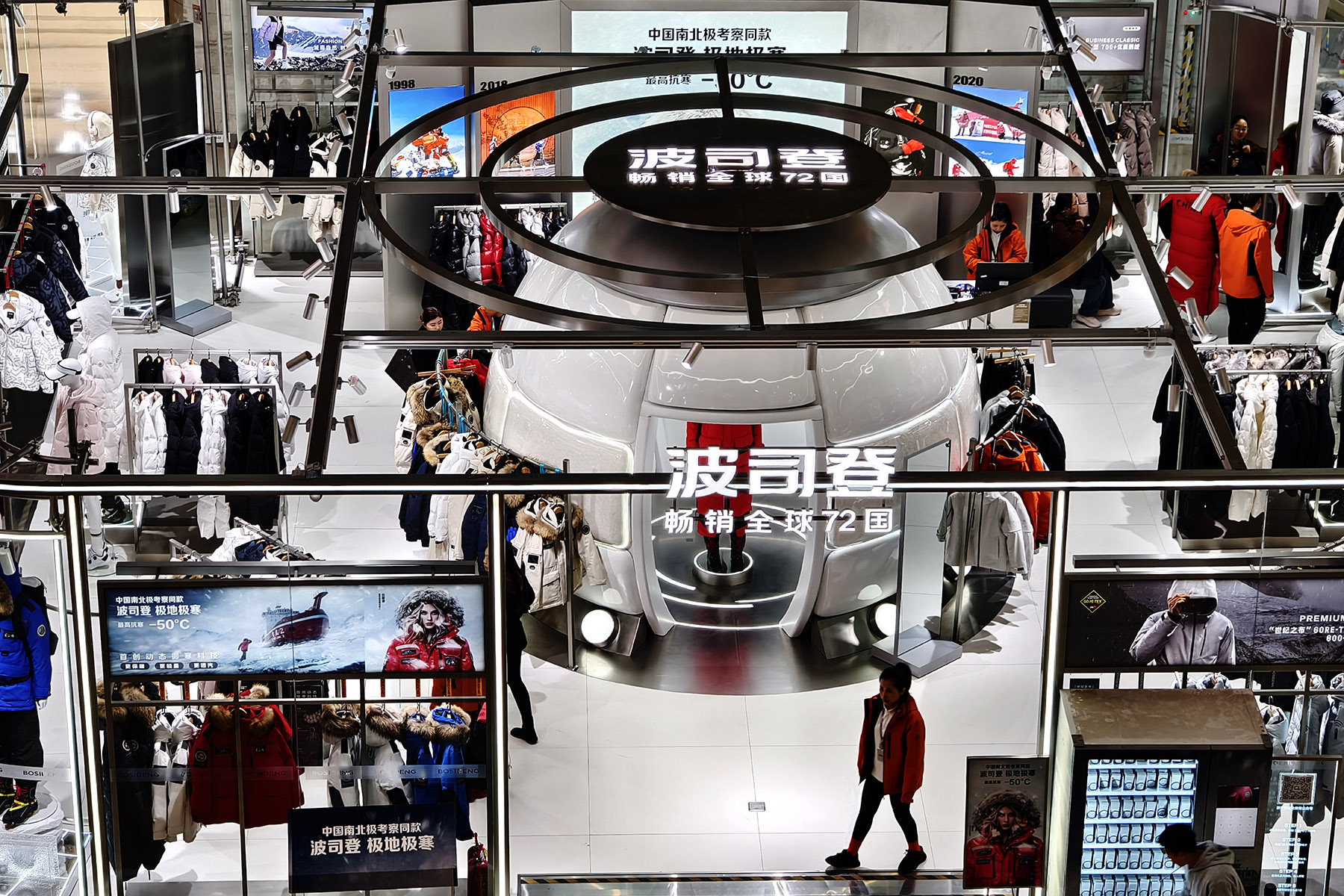Despite concerns over cost, quality and increased competition, chilly winter giving boost to sector

The down apparel market is experiencing a surge as colder weather arrives, pushing up sales for domestic and international brands, despite rising concerns over costs, quality and increased competition.
Bosideng, a leading player in the down apparel market, opened its new concept store in the Sanlitun shopping area of Beijing on Saturday. The new store features high-end down jackets, priced between 1,000 yuan ($138) and 6,000 yuan.
The expansion of retail stores reflects its booming business in the country. In the first half of its fiscal year 2024, Bosideng reported a revenue growth of 17.83 percent year-on-year to 8.8 billion yuan, and its operating profit increased by 19.6 percent to 1.47 billion yuan, with operating profit margin growing to 16.7 percent.
READ MORE: Conference aims to boost consumption
Down jacket sales accounted for 6 billion yuan, a 22.7 percent increase year-on-year, while its high-end Bosideng brand down jackets recorded 5.2 billion yuan in revenue, up 19.4 percent.
The group also balances with affordability. Its Snow Flying brand, targeted at female customers aged between 18 and 35, grew 47.1 percent to 390 million yuan.
During the recent Double 11 shopping festival, Bosideng ranked second in Tmall's clothing category, achieving over 1 billion yuan in sales.
Gao Dekang, chairman and CEO of Bosideng, said: "Focusing on the mainstay business of down jackets as well as fashionable and functional apparel enhanced with technology is the way forward for the group's development."
Bosideng has also recently launched a co-branded collection with Harbin, also known as the ice city and capital of Heilongjiang province. The collection blends urban aesthetics with cold weather functionality to appeal to younger consumers who value both style and performance.
A recent research report by Shanxi Securities said that Bosideng should be aware of the risks of rising raw material costs and intensified brand competition.
However, the report said that in the short term, due to widespread cold weather across the country since mid to late November, the down jacket category has entered peak sales season, and Bosideng is expected to grow further, leveraging its high-quality supply chain and quick response capability.
The size of China's down apparel market rapidly increased to 196 billion yuan in 2023, according to Huayuan Securities. It is expected that by 2028, the scale of the industry will maintain rapid growth, with a compound annual growth rate expected to reach around 11 percent, said the company.
Chinese consumers remain enthusiastic about down jackets, particularly those that offer both functionality and style. The market is broadly divided into three segments: luxury brands, outdoor and technical apparel, and domestic or mass-market offerings.

According to a white paper published by the China Feather and Down Industrial Association and fashion media LUXE.CO, China is the world's largest producer, exporter and consumer of down and down products, accounting for 70 to 80 percent of global market share.
Nearly four out of 10 people surveyed considered down apparel "very crucial" to their winter wardrobe, said the report.
Of medium and high-income consumers surveyed, eight out 10 considered goose down as better fillings for their jackets to stay warm.
Guvet, a high-end domestic brand based in Zhejiang province, has positioned itself as a global contender, with investment focusing on technology, fabrics and raw materials.
With sourcing of goose down from regions like Hungary and Canada, Guvet aims to rival luxury names like Moncler.
The company has conducted research with fashion and luxury professionals in Paris, Milan and Shanghai. It recently launched flagship stores in high-end shopping malls such as La Samaritaine in Paris and SKP in Beijing.
Wu Kunming, founder and chairman of Guvet, said: "Today's consumers are better equipped to evaluate the quality of products. What some perceive as pickiness is actually a quest for high-value offerings."
This shift in consumer behavior is pushing brands to innovate. Beyond traditional down jackets, companies are exploring advanced materials and designs that cater to specific needs. For instance, antibacterial and tear-resistant fabrics are becoming standard features in premium offerings. At the same time, collaborations with global designers and institutions are helping Chinese brands gain international recognition.
Guvet recently collaborated with FBZ Group, a leading goose down production base in Hungary, to secure its supply of quality and sustainable materials.
"This has been the first year of working together, and we supplied a significant quantity, but there is still room to grow. We will increase the supply quantity year-by-year and build up our business," said Nandor Baradacs, marketing director of FBZ Group, "Reliable suppliers will become increasingly important as the supply of raw materials decreases while demand grows."
International brands have also accelerated their focus on the winter apparel category.
Lululemon, an athleisure apparel producer, doubled down on its winter jackets category to penetrate northern markets. To better resonate with Gen Z, Lululemon introduced the "Wunder Puff Movement Theater" during its partnership featuring top Chinese figure skaters to launch the pop up store in Harbin in October of this year.
Canada Goose, in its second quarter report, saw business in the Chinese market up 5.7 percent year-on-year to 46.4 million Canadian dollars ($32.7 million). Operating 28 stores in the market, the company launched its live shopping channel on the Chinese platform, Douyin, enabling it to engage in strong brand storytelling and grow awareness with a large audience in a key market, said the company.
Carrie Baker, president of Canada Goose, said during the earnings call for its second quarter results, "our performance in these early days on Douyin is strong and contributed meaningfully to our Asia Pacific e-commerce revenue in the second quarter. And we were successful in expanding our audience, both on social and our own communities."
Canada Goose performed well in the Chinese mainland market in October, leading to a low single-digit increase in total direct-to — consumer comparable sales growth for the month, according to the company.
Globally, the growing number of middle-income consumers is considered a factor in driving the sector's expansion. Over the past decade, the global down jacket market has been increasing and is expected to continue growing.
However, the supply of down and feathers will not be easy to increase, as the main factor of the goose and down supply is the animals raised for it. "This has led to a future with less supply but increasing demand," said Baradacs.
ALSO READ: Protective clothing market sizzles as awareness rises
China dominates the global down supply chain, producing 88 percent of the world's down and feathers, according to the China Feather and Down Industrial Association.
The raw materials of down, the essence of any down jacket, have seen costs rise over the past year in China.
In 2023, the production of ducks grown for meat dropped to 4.2 billion, down from a high of 4.8 billion in 2019. A similar pattern happened with geese grown for meat, which dropped to 515 million from 630 million during the same period.
This reduction, coupled with extreme weather events and increasing demand, have driven prices higher.
The cost of 90 percent white duck down had risen by 32.7 percent year-on-year by Nov 15, while white goose down had increased by 19.8 percent, said cn-down.com, a platform for down commodity information and services based in Wuchuan, Guangdong province.


